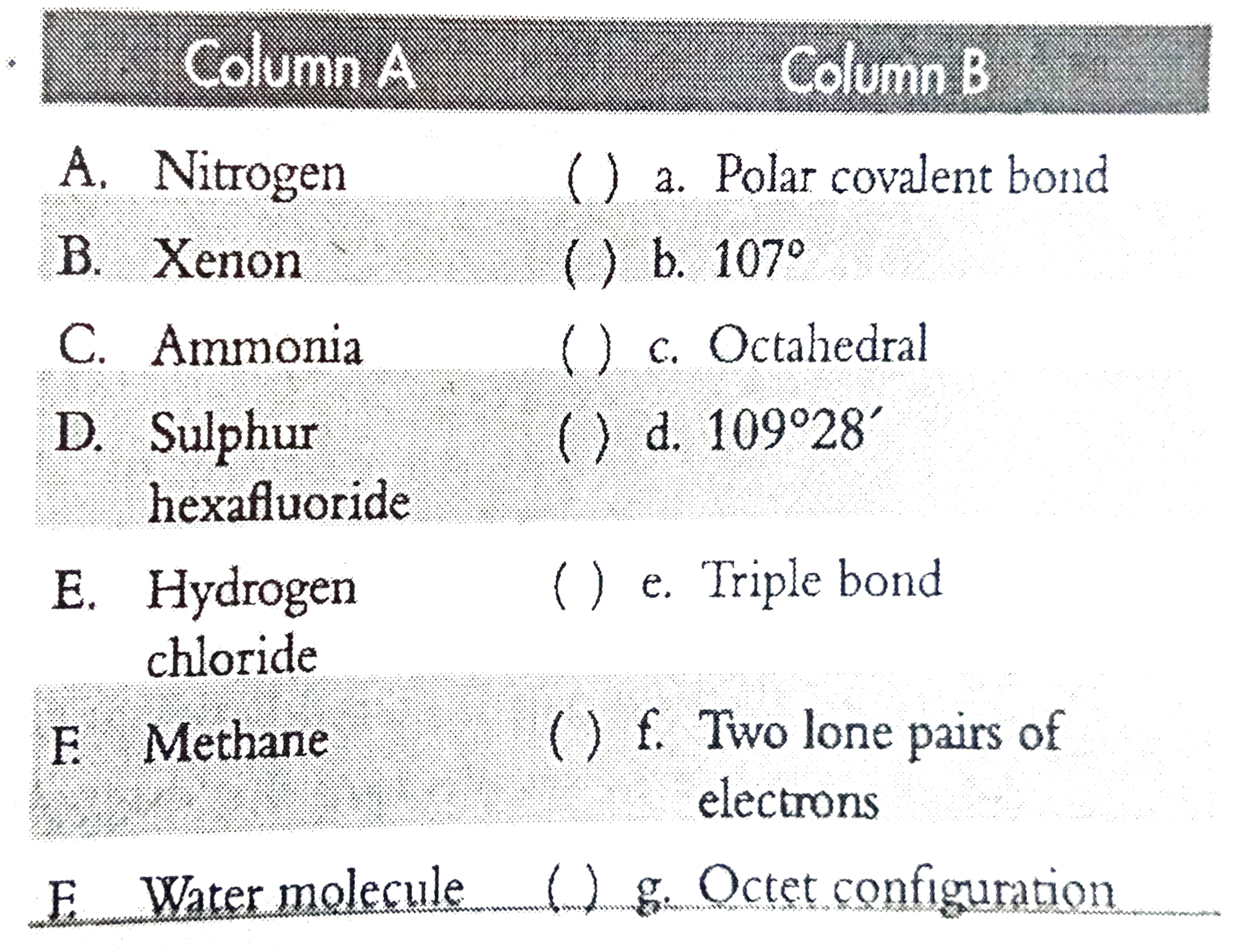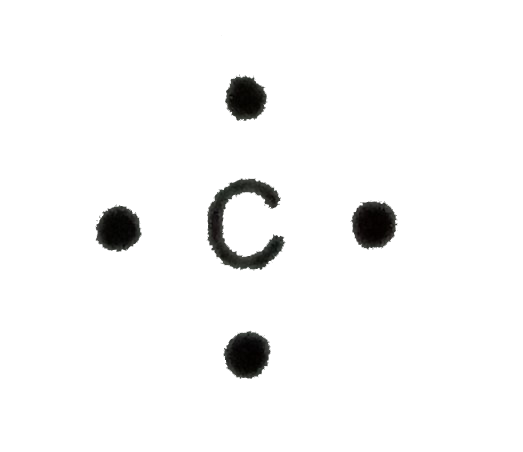Complete Solutions to Level 1 of chapter CHEMICAL BONDING of Class 10 book with complete answers and questions
| Class 10 | CHEMISTRY |
| Chapter | CHEMICAL BONDING |
| PEARSON IIT JEE FOUNDATION | Level 1 |
| Number Of Questions | 44 |
| Academic Year | 2023-24 |
Ionic compounds are soluble in organic solvents.
View Solution`BF_(3)` does not obey the octet rule.
View SolutionThe bond angle in ammonia is `109^(@)28`.
View SolutionSigma bond is stronger than the pi bond. Explain.
View SolutionThe hydrogen bond is always formed between the molecules of the same substance.
View SolutionCovalent bonds are non-directional bonds.
View SolutionIn `CaF_(2)`, the number of electron(s) transferred from calcium to fluorine atoms is ______.
View SolutionThe bond formed by end on overlap is ______ than the bond formed by side on overlap.
View SolutionLinear overlapping of any two pure atomic p-orbitals lead to ______ bond formation.
View SolutionCl-C-Cl bond angle in `C Cl_(4)` is ______.
View SolutionAmong the hydrogen halides ______ has maximum ionic character.
View SolutionThe shape of `BeCl_(2)` is ______.
View SolutionIn ammonia-boron trifluoride complex, the donor molecule is ______.
View SolutionMatch the entries given in Column A with appropriate ones form Column B.

View SolutionExpanded octet occurs in
View SolutionThe lesser covalency of `FeCl_(2)` over `FeCl_(3)` is due to
View SolutionAn element X has low ionisation energy and another element Y has high electron affinity. The bond formed between them could be
View SolutionWhich of the following statement regarding pi bond is not true?
View SolutionArrange the following in increasing order of their bond lengths.
`C-C, C=C, C-=C`
View SolutionWhich of the following statements is wrong?
View Solution`NH_(4)^(+)` is isostructural with
View SolutionIn water molecule, the bond angle of `104.5^(@)` around oxygen is accounted due to
View SolutionWhich of the following bonds is more polar when compared to other?
View SolutionThe number of sigma and pi bonds in benzene are
View SolutionWhich among the following pairs of molecules possess same geometry?
View SolutionThe number of `sigma` and `pi` bonds in `C_(2)H_(2)` is ______
View SolutionA species `H_(3)O^(+)` pyramidal in shape. The number of lone pairs of electrons is
View SolutionThe shape of `H_(2)O` molecule is ______.
View SolutionThe covalency of 'N' in `NH_(4)^(+)` ion is equal to number of
View SolutionTwo substances X and Y are dissolved in water under suitable conditions. X is a gas while Y is a solid under normal conditions. Solution of Y is found to conduct electricity but not 'X'. Based on the conclusion identify the nature of bond present in X and Y with appropriate reasons as given below.
Arrange the steps given below in a sequence.
(1) Y is a solid at room temperature and its aqueous solution conducts electricity. This shows that it is an ionic compound.
(2) X on dissolution in water does not conduct electricity and is a gas at room temperature. Hence it should be a non-polar covalent molecule.
(3) Aqueous solutions of both ionic compounds and polar covalent compounds conduct electricity because of the presence of free ions.
(4) All ionic compounds are solids and most of the non-polar covalent molecules are gases or solids at room temperature. Polar covalent compounds are liquids or gases.
View SolutionThe formation of double bond in an oxygen molecule is explained below. Arrange the given points in a sequential order.
(1) `2p_(y)` orbitals of each oxygen atom overlap laterally/sidewise to form a pi bond.
(2) Thus, double bond between two oxygen atoms in which one `p_(z)-p_(z)` sigma bond and `p_(y)-p_(y)` pi bond is formed.
ltimg src="https://d10lpgp6xz60nq.cloudfront.net/physics_images/PS_CHM_X_C04_E04_032_Q01.png" width="80%"gt
(3) All the three 2p orbitals are perpendicular to each other. Hence, `2p_(z)` orbitals of each oxygen atom overlap end to end to form a sigma bond.
(4) The electronic configuration of oxygen is O: `1s^(2)2_(s)^(2)2p_(x)^(1)2p_(y)^(2)2p_(z)^(1)`.
View SolutionThe necessary steps required to show the formation of `C Cl_(4)` by Lewis electron dot diagram have been jumbled. Arrange them in a sequence.
ltimg src="https://d10lpgp6xz60nq.cloudfront.net/physics_images/PS_CHM_X_C04_E04_033_Q01.png" width="80%"gt
(1) Thus, an electron pair is shared between C and Cl. This is the Lewis electron dot diagram for `C Cl_(4)`.
(2) Write the symbol of chlorine and represent its valence electrons with the help of crosses, that is,
ltimg src="https://d10lpgp6xz60nq.cloudfront.net/physics_images/PS_CHM_X_C04_E04_033_Q02.png" width="80%"gt
(3) Write the symbol of carbon and represent its valence electrons with the help of dots, that is,

(4) When carbon combines with four chlorine atoms, the carbon atom contributes four electrons for sharing, whereas each chlorine atom contributes only one electron for sharing. Thus, both the atoms in `C Cl_(4)` attain an octet.
View SolutionWhich among the following substances does not conduct electricity in its aqueous solution state?
View SolutionThe ease of formation of which of following chlorides is maximum?
View SolutionDuring the formation of sodium chloride from its constituents,
View SolutionThe valence electronic configurations of two elements are `4s^(1)` and `3s^(2) 3p^(5)`. The type of bond expected to be present between them is
View SolutionThe angular shape of water molecule is due to
View SolutionThe element that has the strongest metallic bond among `._(11)A^(23), ._(12)B^(24), ._(13)C^(27)` and `._(19)D^(39)` is ______.
View SolutionIdentify the compound that exhibits maximum ionic character among the following:
View SolutionIdentify the favourable conditions for the formation of ionic bond:
View SolutionAmong the following molecules, p-p overlap takes place in
View SolutionAmong the following molecules H-bond is present in
View SolutionThe covalency of oxygen in hydronium ion is equal to number of
View SolutionA solid compound 'A' consists of simple ions. Choose corresponding answers from the choices given below.
Natural of the bond present in A will be
View Solution
Level 1 questions and complete solutions for chapter CHEMICAL BONDING of PEARSON IIT JEE FOUNDATION of Class 10